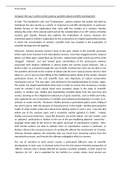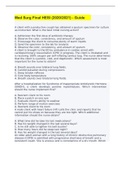Prose essays
Compare the way in which writers portray anxieties about scientific development
In both ‘The handmaid’s tale’ and ‘Frankenstein’, authors explore the anxiety felt both by
individuals but also society as a whole, in response to scientific development. In particular,
Shelley focuses on the implications that come with the creation of a creature, thereby
defying the order of the natural world and (in the consideration of an 18 th century Christian
society), god. Equally, Atwood also explores the implications of science, however she
somewhat upturns Shelley’s exploration by the construction of a highly-hyperbolised society
in which the accumulation of society’s scientific fears has resulted in the eradication of
scientific development all together.
Moreover, Atwood presents society’s fears of the past, rooted in the scientific processes
which used to be involved in the reproductive process ‘once they drugged women, induced
labour, cut them open, sewed them up. No more’, indeed Aunt Lydia’s harsh use of the verbs
‘drugged’, ‘induced’, ‘cut’ and ‘sewed’ gives connotations of the unnecessary violence
associated with modern childbirth; it almost makes the women sound inhuman, ‘like a
broken robot’ as conveyed through this use of simile. Furthermore, here we are able to see
the anxieties which led to the creation of Gilead and the more natural process which is then
taken on, as it is seen as more fitting of the traditional puritan ideals of the society. Atwood
particularly draws on the real scientific fears and objections of radical conservative
movements such as ‘The new right’, who believed in the traditionalisation of society. Again,
the author has simply hyperbolised these fears in order to convey how monstrous a society
could be created if such radical ideals were accepted, simply in the wake of scientific
anxiety. In another way, Shelley also hyperbolises scientific ideals from her own time and
society, drawing on the enlightenist endeavours of great scientists, such as Aldini and Volta,
who explored the use of electricity in scientific and anatomical development, in order to re-
animate or create new life. Moreover, Shelley portrays a particularly gothic scene, fitting of
the novel’s genre, with the purpose of inducing terror in the reader, thereby portraying the
reality of what results could come about from defying nature in such a way ‘I saw the dull
yellow eye of the creature open, and a convulsive motion agitated it’s limbs’ . Indeed,
Shelley uses harsh verbs here , much like Atwood’s use of the violent ‘cut’ and ‘sewed’, such
as ‘agitated’, particularly in relation to the use of the pre-modifying adjective ‘convulsive’ ;
language which adds all the more to this gothic portrayal of reproductive creation. Here,
both female authors are able to indicate fears of reproductive science in particular, as
Shelley criticises the unnatural process of creating life without the involvement of a female,
whereas Atwood explores the extremity that can result from removing science from the
reproductive process, and thereby the ultimate subjegative effect on women.
The use of narration in both novels creates a particularly different view of scientific
development in each case, as Atwood writes from the first person feminine perspective of
‘Offred’, somone who is deeply affected by society’s scientific anxieties, in their search for
‘ripeness, for rot’ ; she is exploited for her fertility in a society where most women are







